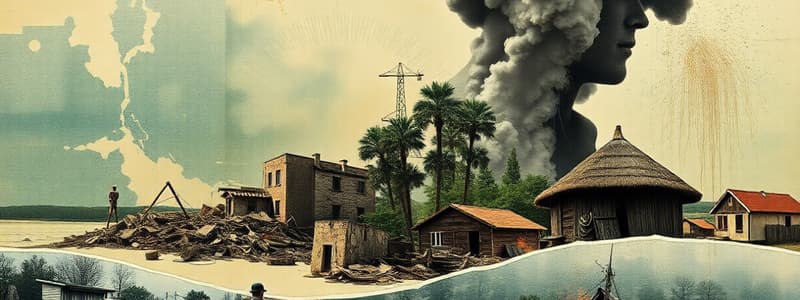Podcast
Questions and Answers
Match the natural disaster with its primary cause:
Match the natural disaster with its primary cause:
Avalanche = Large accumulation of snow Tsunami = Ground displacement Earthquake = Seismic activity Volcanic Eruption = Magma movement
Match the natural disaster with its characteristic:
Match the natural disaster with its characteristic:
Avalanche = Rapid snow movement down mountains Tsunami = High waves in oceans Flood = Overflow of water onto land Landslide = Movement of rock and soil down a slope
Match the natural disaster with its potential consequence:
Match the natural disaster with its potential consequence:
Avalanche = Hypothermia risk Tsunami = Coastal flooding Earthquake = Structural collapse Volcanic Eruption = Lava flow
Match the natural disaster with the survival challenge:
Match the natural disaster with the survival challenge:
Match the natural disaster to its type:
Match the natural disaster to its type:
Match the following natural disasters with their descriptions:
Match the following natural disasters with their descriptions:
Match the type of disaster with its scale of impact:
Match the type of disaster with its scale of impact:
Match the causes of disasters with their corresponding type:
Match the causes of disasters with their corresponding type:
Match the following terms with their explanations:
Match the following terms with their explanations:
Match the following disasters with their potential consequences:
Match the following disasters with their potential consequences:
Flashcards are hidden until you start studying
Study Notes
Overview of Natural Disasters
- Natural disasters are unforeseen events causing harm to society and the environment.
- Common types include earthquakes, cyclones, floods, tsunamis, landslides, volcanic eruptions, and avalanches.
Levels of Disasters
- Small Scale Disasters:
- Extent: 50 to 100 kilometers.
- Generally cause minimal damage.
- Medium Scale Disasters:
- Extent: 100 to 500 kilometers.
- Cause more significant damage, particularly in colonial states.
- Large Scale Disasters:
- Extent: Over 1,000 kilometers.
- Result in severe environmental damage; can devastate entire countries.
Types of Natural Disasters
-
Earthquakes:
- Shaking or vibrating of the earth; can vary from weak (unnoticed) to strong (destructive).
- Can lead to secondary disasters like landslides and tsunamis.
- Caused by the release of energy from the Earth's core, rupturing geological faults.
-
Landslides:
- Movement of large rocks or debris down slopes, common in mountainous and hilly areas.
- Can cause substantial destruction to human structures.
- Triggered by gravitational pull, earthquakes, volcanic eruptions, and deforestation-induced soil erosion.
-
Avalanches:
- Masses of snow falling down slopes; akin to landslides but involve snow.
- Extremely damaging to anything in their path.
- Risks include high fatalities, often due to hypothermia.
-
Tsunamis:
- High waves in oceans, predominantly caused by ground displacement (e.g., earthquakes).
- Can lead to coastal flooding, potentially involving multiple, fast-moving waves.
- Survivability is low as people cannot outrun them.
Key Causes of Natural Disasters
- Earthquakes stem from energy releases from the Earth's core and geological fault ruptures.
- Landslides and avalanches can be initiated by natural forces like gravity and geological events, as well as human activities.
- Tsunamis primarily result from seismic activity underwater, differing from regular waves influenced by wind.
Impact and Mitigation
- Natural disasters can cause immense damage to human society and the environment.
- Preventive measures can help reduce the potential impact of these disasters.
Studying That Suits You
Use AI to generate personalized quizzes and flashcards to suit your learning preferences.





